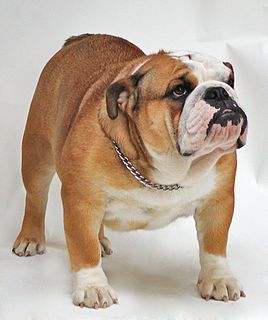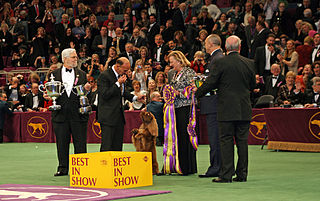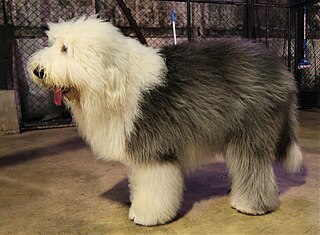
The cephalic index or cranial index is the ratio of the maximum width of the head of an organism multiplied by 100 divided by its maximum length. The index is also used to categorize animals, especially dogs and cats.

The American Kennel Club (AKC) is a registry of purebred dog pedigrees in the United States. In addition to maintaining its pedigree registry, this kennel club also promotes and sanctions events for purebred dogs, including the Westminster Kennel Club Dog Show, an annual event which predates the official forming of the AKC, the National Dog Show and the AKC National Championship sponsored by Royal Canin, formerly the AKC/Eukanuba National Championship. Unlike most other countries' kennels clubs, the AKC is not part of the Fédération Cynologique Internationale.

The Canadian Kennel Club is the national kennel club of Canada. The Canadian Kennel Club maintains breed registries services for all purebred dogs it officially recognizes and provides governance for all CKC approved dog conformation shows, dog trials and canine events.

Fox Terriers are two different breeds of the terrier dog type: the Smooth Fox Terrier and the Wire Fox Terrier. Both of these breeds originated in the 19th century from a handful of dogs who are descended from earlier varieties of British terriers, and are related to other modern white terrier breeds. In addition, a number of breeds have diverged from these two main types of fox terrier and have been recognised separately, including the Jack Russell Terrier, Miniature Fox Terrier and Rat Terrier. The Wire and Smooth Fox Terriers share similar characteristics, the main differences being in the coat and markings. They have been successful in conformation shows, more prominently in America than their homeland.

The French Bulldog is a small breed of domestic dog. They were the result in the 1800s of a cross between bulldog ancestors imported from England and local ratters in Paris, France.

A companion dog is a dog that does not work, providing only companionship as a pet, rather than usefulness by doing specific tasks. Many of the toy dog breeds are used only for the pleasure of their company, not as workers. Any dog can be a companion dog, and many working types such as retrievers are enjoyed primarily for their friendly nature as a family pet, as are mixed breed dogs. The American Kennel Club also offers a Companion dog title for judged dog obedience competitions.
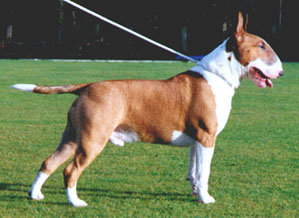
The Bull Terrier is a breed of dog in the terrier family. There is also a miniature version of this breed which is officially known as the Miniature Bull Terrier.
The American Rare Breed Association or ARBA is a national dog association of the United States, based in Cheltenham, Prince George's County, Maryland. The club was formed to register, show, educate and promote the breeding of uncommon dog breeds. ARBA handles breeds recognized by the Fédération Cynologique Internationale or by its own board of directors that are not yet recognized by the American Kennel Club.
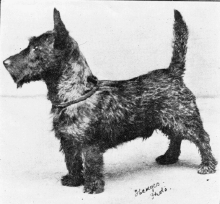
Ch. Tickle Em Jock (1908–??), a Scottish Terrier, was the first of his breed to win best-in-show at the Westminster Kennel Club Dog Show in 1911, the fifth occasion it was awarded. He was originally sold for a sum of only £2 to Andrew Albright, Jr. Mr Albright would go on to later say he wouldn't sell the dog for $5,000. Jock was also noted in the media of the time for biting a judge's wrist just after winning best of breed at a dog show.
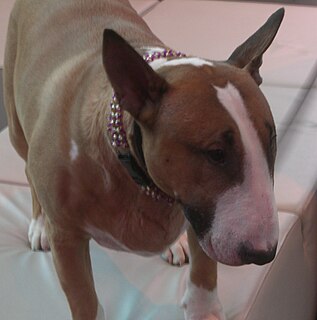
Ch. Rocky Top's Sundance Kid was a Bull Terrier who is best known for being the 2006 Best In Show winner at the Westminster Dog Showhandled by Kathy Kirk PHA. He is the first Colored Bull Terrier to win Best in Show at Westminster, with the only other victory for his breed going to a White Bull Terrier in 1918. He also won Best In Show at the National Dog show, and on retirement trained as a therapy dog. He is the most successful Colored Bull Terrier Show Dog of all time.
The Intelligence of Dogs is a book on dog intelligence by Stanley Coren, a professor of canine psychology at the University of British Columbia in Vancouver. Published in 1994, the book explains Coren's theories about the differences in intelligence between different breeds of dogs. Coren published a second edition in 2006.

Ch. Kenmare Sorceress (1909–??), an Airedale Terrier, was the first of its breed to have won the Westminster Kennel Club Dog Show, in 1912. She was originally from Wales, but was imported into the United States by William P. Wolcott in September 1910.
NORD Ch. Topscore Contradiction, also known as King, is a standard sized Poodle, who was the winner of the title of Best In Show at the Crufts dog show in 2002. He was the first overseas dog and the first undocked dog from a breed which was previously docked in the UK to win the title.

Ch. Boxwood Barkentine, an Airedale Terrier, was the Best in Show at the 1922 Westminster Kennel Club Dog Show, the third occasion it was awarded to a member of that breed. It was the first show that Barkentine had been entered into as an adult.

Ch. Warren Remedy, (1905-1912), was a Best in Show winner of the Westminster Kennel Club Dog Show in 1907, 1908, and 1909. She was a Smooth-coated fox terrier owned by Winthrop Rutherfurd, and is the only dog to have won Westminster three years in a row.
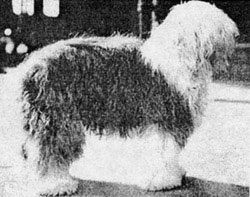
Ch. Slumber was an Old English Sheepdog that won best in show at the Westminster Kennel Club Dog Show in 1914. He was owned by Ms. Taylor Vic and was "hands down" the winner of the show. Slumber's win in 1914 is credited with having promoted the popularity of the breed today.

GCH Banana Joe V Tani Kazari, also known as Joe, is a 11 year old toy Affenpinscher that won Best In Show at the 137th Westminster Kennel Club Dog Show on February 12, 2013. Banana Joe was the first of his breed to win Best in Show at Madison Square Garden. This was his last show, and following it Joe went home to the Netherlands to be with his owner Mieke Cooijmans.


